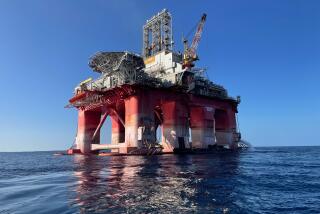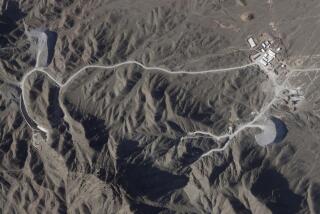Libya Speeds Work on New Missile Site
- Share via
WASHINGTON — Libya has speeded up work on a second sophisticated missile site along its coast and by mid-April will be able to cover the airspace over the disputed Gulf of Sidra with long-range surface-to-air missiles, Pentagon sources said Tuesday.
U.S. aircraft launched from carriers operating during maneuvers in the central Mediterranean on March 24 were attacked by four, or possibly five, Soviet-made SAM-5s fired from a missile-launching site at Surt. Officials now believe that by the middle of this month, a site at Benghazi, nearly 200 miles northeast of Surt, will also be capable of firing the 150-mile-range missiles.
“They’re now working around the clock to bring up the Benghazi site,” one source said. He said no sign has been detected that Soviets are assisting in the accelerated work.
Site Still Operational
In addition, Pentagon officials said that the site at Surt, on the southern shore of the Gulf of Sidra, is still operational, despite being hit twice by Navy jets last week after U.S. forces were attacked by Libya. The Libyans said the United States encroached on their territory.
The missiles fired from the Surt base could have hit American planes flying in the region, but U.S. aircraft managed to disable radar signals guiding the projectiles. This same jamming tactic could be used to confuse missiles fired from the new site at Benghazi, but the second facility would make it more difficult to carry out flight operations as extensive as those conducted last week, said the sources, who spoke on the condition that they not be identified.
The second missile site would not prohibit such maneuvers but would give Libya “virtually total coverage of the Gulf of Sidra, well into” the central Mediterranean north of the gulf, one senior official said.
Defense Secretary Caspar W. Weinberger said that airplanes from the carriers Saratoga, Coral Sea and America made 188 flights last week beyond the mouth of the gulf, across which Col. Moammar Kadafi has drawn his so-called “line of death.”
Kadafi has claimed the entire gulf--about 150 miles north of the Libyan coast at its farthest point--as Libyan territory. However, the United States recognizes as international territory any waters beyond 12 miles from the coast.
Weinberger, President Reagan, Secretary of State George P. Shultz and Adm. William J. Crowe Jr., chairman of the Joint Chiefs of Staff, have portrayed the operation as an exercise to protect the United States’ right to operate in international territory, saying military objectives--if any--were considered secondary.
However, when Libya unleashed the SAM-5s from launchers at Surt, Navy A-7 ground-attack aircraft struck the site with high-speed, anti-radiation (HARM) missiles, which home in on the radar system that guides the surface-to-air missiles.
The SAM-5 is considered effective against large, slow-moving, high-altitude aircraft, but officials said the sophisticated fighters and light bombers flown by the Navy encountered no serious problems against the weapons. The U.S. aircraft were apparently aided by effective electronic jamming conducted by EA-6B Prowlers to confuse the radar system that guides the surface-to-air missiles.
Pentagon officials expressed concern late last year that the deployment of the missiles would extend the range of Libyan air defenses from the approximately 30-mile range of their SAM-2 missiles to the 150 miles or more that the SAM-5 can reach.
“This clearly exceeds any legitimate security requirements the Libyans have. This is a significant and dangerous escalation in the Soviet-Libyan arms relationship,” State Department spokesman Charles Redman said at the time.
By installing a second missile site, with about 10 additional launchers, the Libyans could “increase the threat area,” a Pentagon official said.
More to Read
Sign up for Essential California
The most important California stories and recommendations in your inbox every morning.
You may occasionally receive promotional content from the Los Angeles Times.













